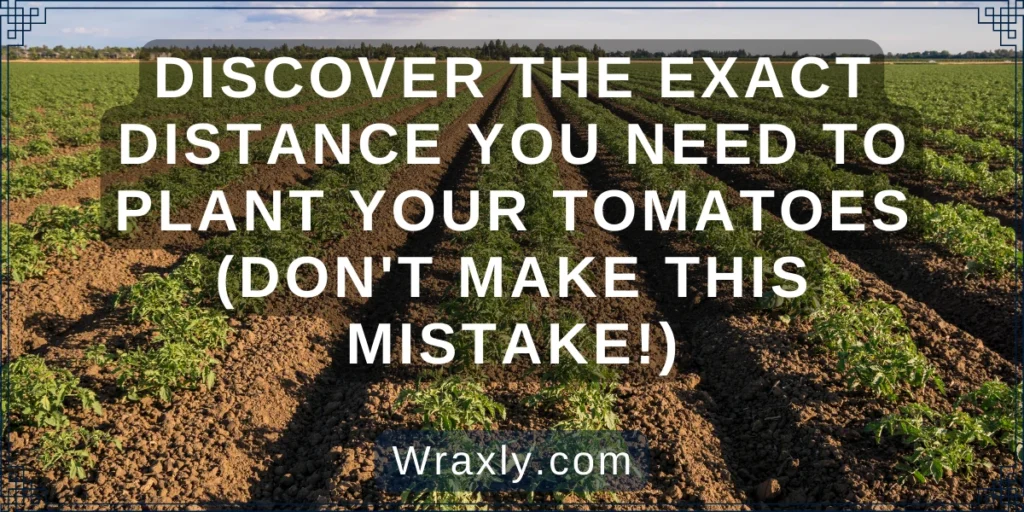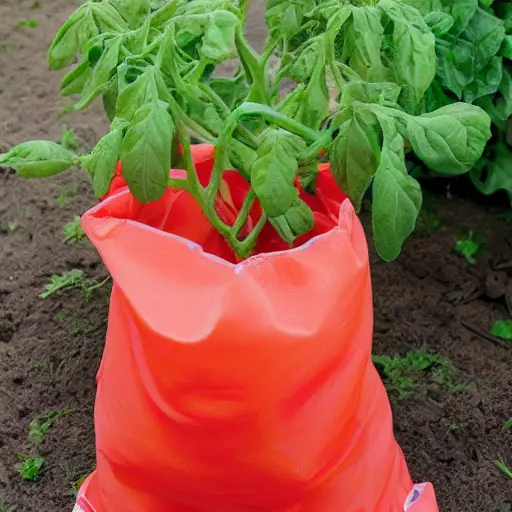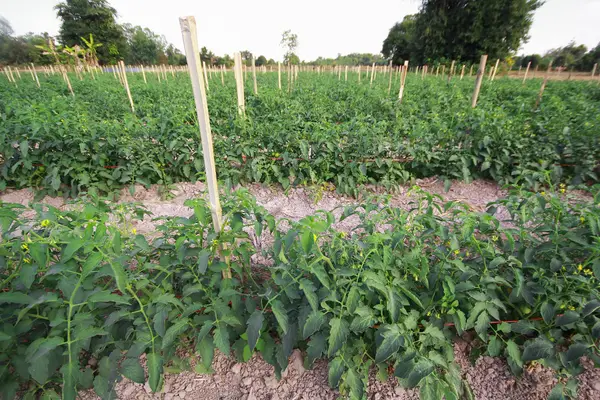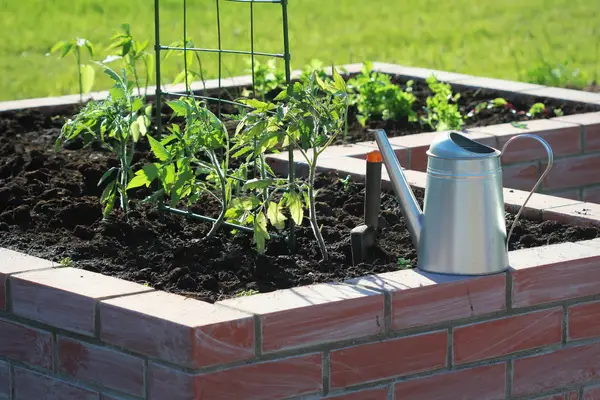Are you wondering how far apart to plant tomatoes? Whether it’s determinate or indeterminate, staked in the ground or planted in a container, tomato spacing is an important factor for growing tomatoes. With all of the different types and varieties out there, it can be tricky to know how much distance you should have between your plants. In this blog post we’ll discuss why spacing is so important when planting tomatoes. Additionally, we will give tips on how far apart to space them by type and variety, grown in raised beds or in your garden. So let’s get started!

Determinate vs Indeterminate Tomatoes
When it comes to tomatoes, there are two main types: determinate and indeterminate. Determinate tomatoes are bush varieties that grow to a certain height and then stop producing fruit. They tend to be smaller plants with shorter vines, making them ideal for container gardening or small spaces.
Indeterminate tomatoes, on the other hand, are vining varieties. They will continue growing and producing fruit until they’re killed by frost or disease. These plants require more space but can produce larger yields of delicious fruits over a longer period of time.
What is the Difference?
Determinate tomato plants have a predetermined growth habit; they grow up to a certain size and then stop producing flowers and fruit. The plant’s energy goes into ripening existing fruits rather than continuing to produce new ones as an indeterminate variety would do. This makes determinates great for gardeners who want their harvest all at once instead of spread out over several weeks or months.

Pros and Cons of Each Type
The biggest advantage of determinates is their compact size; these plants don’t take up much room in your garden so you can fit more into limited spaces such as containers or raised beds. On the downside, since these plants only produce one large crop at once, you’ll need to plan ahead if you want your harvest spread out throughout the season—you may need multiple planting dates for this purpose.
Indeterminates offer greater yields overall but require more space due to their sprawling nature; plus they’re prone to diseases such as late blight which can devastate entire crops if not managed properly (especially in wet climates).
How To Choose The Right Variety For Your Garden
Choosing between determinate and indeterminate varieties of tomatoes really depends on the available space you have for your garden. If you are limited in space, determinates may be a better option. They will provide fresh-picked tomatoes during summertime barbecues.
However, if you have plenty of room in your yard, then an indeterminate variety might be more suitable. Regardless of which type is chosen, regular care such as pruning off dead leaves/vines is necessary to ensure optimal growth and health. Make sure this fits within your maintenance schedule before making a decision.
Knowing the differences between determinate and indeterminate tomatoes is essential for selecting the right variety for your garden. Now, let’s look at planting tomatoes in containers.
Key Takeaway: When it comes to planting tomatoes, there are two main types: determinate and indeterminate. Determinates are better for limited space since they only produce one large crop at once, while indeterminates offer greater yields but require more space due to their sprawling nature. Choosing the right variety depends on available space and how much maintenance you are able to provide. Regular care such as pruning is necessary for optimal growth regardless of type chosen.
Container Planting Tomatoes
Container planting tomatoes is a great way to enjoy the fruits of your labor without taking up too much space. The right container can make all the difference when it comes to growing tomatoes, so it’s important to choose wisely.
What Containers are Best?
When selecting a container for tomato plants, look for one that is at least 12 inches deep and 18 inches wide with drainage holes in the bottom. Fabric grow bags are great options also. Plastic or clay pots work well, as do hanging baskets and half barrels. If you have limited space, consider using self-watering containers or vertical planters. Make sure whatever type of container you choose has enough room for roots to grow and spread out before filling it with soil.

Tips for Planting in Containers
Before planting your tomato seedlings in their new home, fill the pot halfway with soil mix specifically designed for containers such as Miracle Gro Moisture Control Potting Mix or Fox Farm Ocean Forest Potting Soil. Add fertilizer according to package instructions then top off with more soil until two thirds full. Next, gently place your plant into its new home and add more soil around it if needed. Once planted water thoroughly but don’t overdo it; soggy conditions can lead to root rot which will kill your plants quickly!
How To Care For Container Grown Tomatoes
Tomato plants need plenty of sunlight, so they should be placed in an area that receives at least 6 hours of direct sun each day (8-10 hours is even better). When watering the plants, check the moisture level first by sticking your finger an inch into the pot. If it is dry, give them a good drink but avoid overwatering.
Fertilize every 2 weeks during active growth periods using a liquid fertilizer diluted according to package instructions. Prune away any dead leaves or stems throughout the season as needed. Finally, remember to harvest regularly once fruit starts appearing on vines; this encourages further production from remaining flowers.
With container planting tomatoes, you can have a successful garden in even the smallest of spaces. Next, let’s discuss the importance of spacing when planting tomatoes.
Key Takeaway: When planting tomatoes in containers, it’s important to choose a pot that is at least 12 inches deep and 18 inches wide with drainage holes. Fill the container halfway with soil mix specifically designed for containers, add fertilizer, then gently place your plant into its new home. Make sure to give your tomato plants plenty of sunlight (6-10 hours per day) and water them regularly but not too much. Fertilize every 2 weeks during active growth periods and prune away any dead leaves or stems as needed. Finally, remember to harvest regularly once fruit starts appearing on vines.
Why Spacing Is Important When Planting Tomatoes
Spacing is an important factor when planting tomatoes. The right amount of space between plants can help ensure healthy growth and a plentiful harvest. Here are some reasons why spacing is important, how to calculate the right amount of space between plants, and common mistakes to avoid when spacing your tomato plants.
The Benefits of Proper Spacing
When it comes to growing tomatoes, proper spacing helps promote air circulation which reduces the risk of disease and encourages strong root development for healthier plants. It also allows more sunlight exposure which leads to bigger fruits with better flavor. Additionally, adequate spacing helps reduce competition for nutrients from other nearby plants.
How To Calculate The Right Amount Of Space Between Plants
Tomato varieties vary in size so it’s important to know how much space each type needs before you start planting them in your garden or containers. Generally speaking, determinate varieties should be spaced 18-24 inches apart while indeterminate varieties need 24-36 inches apart. Specific spacing will depend on their size at maturity (check seed packet or plant tag). If you’re planting multiple rows of tomatoes, leave 3-4 feet between rows.

One mistake many people make is not leaving enough room between tomato plants, resulting in overcrowding. This can lead to stunted growth due to lack of light exposure and air circulation. Additionally, it can lead to increased competition among neighboring roots for resources like water and nutrients from the soil, leading to smaller yields overall.
Another common mistake is not taking into account the mature size of a particular variety when calculating how far apart they should be planted; this could result in too little space being left once they reach full size. This could lead to reduced yields due to overcrowding if corrective action isn’t taken quickly enough. Actions to take include thinning out extra seedlings, or transplanting some elsewhere with more room available.
Properly spacing your tomato plants is essential to ensure they get enough sunlight, water and nutrients. Next, we’ll discuss tomato spacing by garden type.
Key Takeaway: Spacing is an important factor when planting tomatoes, as it helps promote air circulation and sunlight exposure while reducing competition for resources. Generally speaking, determinate varieties should be spaced 18-24 inches apart while indeterminate varieties need 24-36 inches apart depending on their size at maturity. Common mistakes to avoid include not leaving enough room between plants or not taking into account the mature size of a particular variety when calculating spacing.
Tomato Spacing by Garden Type
When it comes to planting tomatoes, spacing is key. Different types of gardens require different amounts of space for tomato plants to thrive.
In-Ground Gardens
When planting in an in-ground garden, the general rule is to plant tomatoes 18 inches apart from each other and 24 inches apart from rows. This allows enough room for the roots to spread out and take up nutrients while also giving the leaves plenty of air circulation which helps prevent disease. If you are growing determinate varieties, such as Roma or Early Girl, then you can get away with planting them closer together at 12 inches apart since they won’t grow much larger than that size anyway.
Raised Beds
Raised beds offer a great way to maximize your gardening space by allowing you to plant more densely than traditional in-ground gardens do. For raised beds, aim for 8–12 inches between plants and 16–24 inches between rows depending on how big the variety grows and how much room there is in the bed itself. It’s important not to overcrowd your raised bed because this will lead to competition among plants for resources like water and sunlight which could stunt their growth or cause disease problems down the line.

Containers & Pots
Containers are a great option if you don’t have a lot of outdoor space but still want fresh homegrown tomatoes! Generally speaking, containers should be at least 10–12 inches deep so that there’s enough soil volume for adequate root development; however bigger pots may be needed depending on what type of tomato variety you’re growing (determinate vs indeterminate). Aim for 6–8 inch spacing between each plant when potting up multiple seedlings into one container; if only one seedling per pot then just make sure there’s about 3–4 inch clearance around all sides so that it has plenty of room as it grows larger over time!
Planting tomatoes correctly requires careful consideration when it comes to spacing, whether in an in-ground garden, raised bed or container/pot. This can significantly affect the overall yield and healthiness of your crop. Make sure that whatever type of garden setup you choose gives each individual plant enough room so they can reach their full potential without competing with neighboring plants for resources such as water or sunlight.
Key Takeaway: In-ground tomato gardens should be 18 inches apart and 24 inches between rows; raised beds should have 8–12 inch spacing between plants and 16–24 inch spacing between rows; containers pots need 6–8 inch spacing for multiple seedlings or 3–4 inch clearance around one seedling per pot. Properly spaced tomato plants will help ensure a healthy crop with maximum yield.
For Further Reading
- Plum Tomatoes Demystified: Growing Tips for Gardens and Containers
- Don’t Plant Cucumbers and Tomatoes Together: Here’s Why
- Unlock the Secret to Growing More Delicious Tomatoes
- The Secret to a Pest-Free Garden: Plant These With Your Tomatoes
- How to Master Hydroponic Tomatoes
FAQs About How Far Apart to Plant Tomatoes
Yes, tomatoes can be planted 12 inches apart. This spacing allows for adequate air circulation and light penetration to the lower leaves of the plant. It also helps reduce disease pressure by keeping foliage dry and preventing overcrowding. Additionally, it gives each tomato enough room to grow without competing with its neighbors for resources like water and nutrients. With this spacing, you’ll have a healthy garden full of delicious tomatoes!
If you plant tomatoes too close together, they will compete for resources such as water and nutrients. This can cause the plants to become stunted and produce fewer fruits. Additionally, overcrowding can lead to disease or pest infestations due to a lack of air circulation. It is important to give each tomato plant enough space so that it has access to adequate sunlight, water, and nutrients in order for it to thrive.

Final Thoughts on How Far Apart to Plant Tomatoes
Depending on the type of tomato you are growing and the size of your garden, there can be a big difference in how far apart to plant tomatoes. Determinate and indeterminate varieties require different amounts of space for optimal growth. Container gardening also requires special considerations for tomato spacing. By taking into account all these factors, you can ensure that your tomatoes have enough room to grow and thrive without overcrowding each other or competing for resources. With proper planning and care, you can create a lush garden with healthy plants that will provide delicious fruits!
Are you looking for the best advice on how to grow juicy tomatoes? Look no further than How to Grow Juicy Tomatoes! This tomato-growing Bible and bestseller in 89 countries will provide you with all the tips and tricks you need to get the best possible harvest from your tomatoes. With advice from two horticulturalists, you’ll learn the right way to prune, fertilize, water and stake your tomatoes. You’ll also be able to diagnose pest and disease problems using step-by-step directions, illustrated with 260 full color photos. Don’t wait any longer to get the freshest and juiciest tomatoes! Get How to Grow Juicy Tomatoes today and start growing your own tomatoes with confidence!

Darrell has a passion for gardening that he inherited from his father. Go here to read more about the influence his father played in his love for gardening. If you want to send Darrell a quick message, then visit his contact page here.

![How to Water Indoor Plants [Plant Care 101]](https://wraxly.com/wp-content/uploads/2021/03/How-to-Water-Indoor-Plants-Plant-Care-101-1200-1024x576.webp)

![Growing Plants from Cuttings [A Simple Guide]](https://wraxly.com/wp-content/uploads/2021/03/Growing-Plants-from-Cuttings-A-Simple-Guide-1200-1024x576.webp)